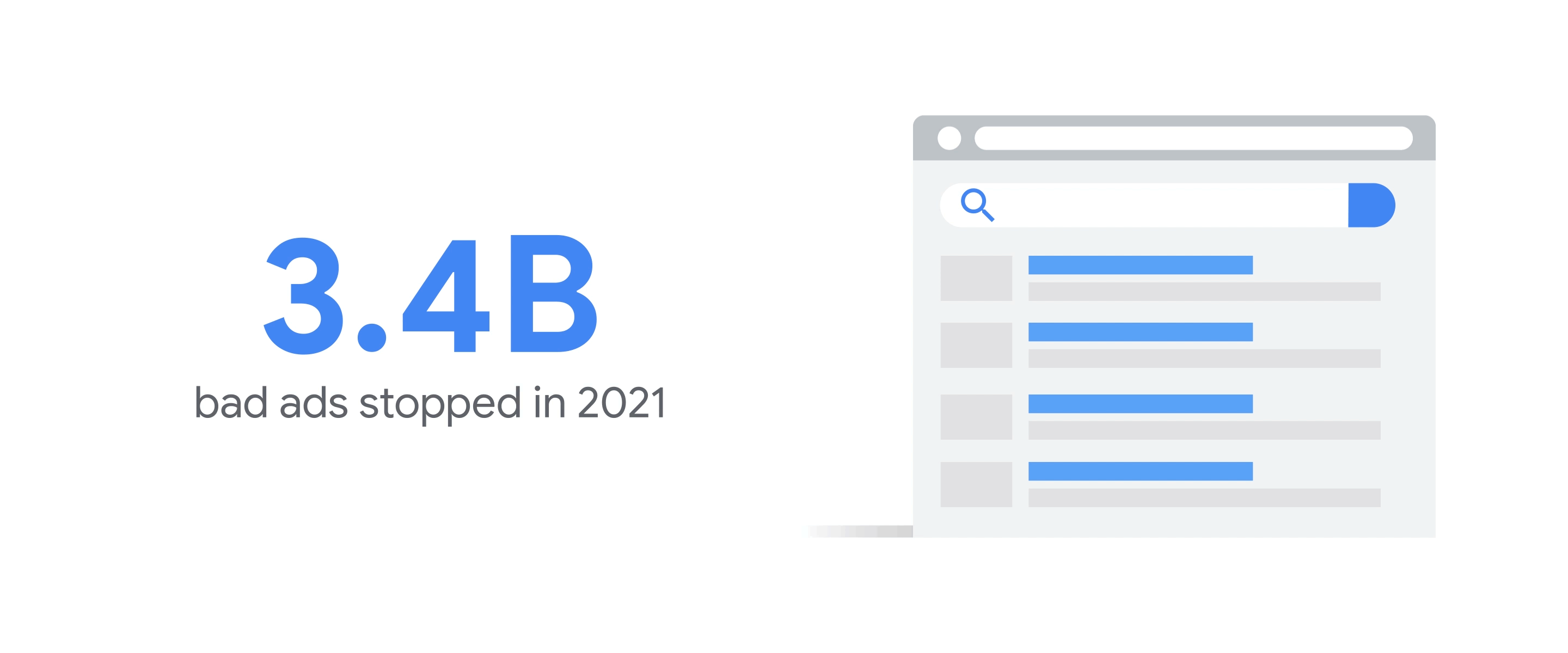User safety is at the top of our list when we make decisions about ads and monetized content on our platforms. In fact, thousands of Googlers work around the clock to prevent malicious use of our advertising services and help make them safer for people, businesses and publishers. We do this important work because an ad-supported internet means everyone can access essential information.
And as the digital world evolves, our policy development and enforcement strategies evolve with it — helping to prevent abuse while allowing businesses to reach new customers and grow. We’ve continued to invest in our policies, teams of experts and enforcement technology to stay ahead of potential threats. In 2021, we introduced a multi-strike system for repeat policy violations. We added or updated over 30 policies for advertisers and publishers including a policy prohibiting claims that promote climate change denial and a certification for U.S.-based health insurance providers to only allow ads from government exchanges, first-party providers and licensed third-party brokers.
In 2021, we removed over 3.4 billion ads, restricted over 5.7 billion ads and suspended over 5.6 million advertiser accounts. We also blocked or restricted ads from serving on 1.7 billion publisher pages, and took broader site-level enforcement action on approximately 63,000 publisher sites.

Check out the entire 2021 Ads Safety Report for enforcement data, and read on for a few of the highlights.
Responding to the war in Ukraine
Though the report only covers 2021, we also wanted to share an update on our response to the war in Ukraine — given it’s top of mind for so many around the world, including our enforcement teams. We acted quickly to institute a sensitive event, prohibiting ads from profiting from or exploiting the situation. This is in addition to our longstanding policies prohibiting content that incites violence or denies the occurrence of tragic events to run as ads or monetize using our services.
We’ve also taken several other steps to pause the majority of our commercial activities in Russia across our products — including pausing ads from showing in Russia and ads from Russian-based advertisers, and pausing monetization of Russian state-funded media across our platforms.
So far, we’ve blocked over eight million ads related to the war in Ukraine under our sensitive event policy and separately removed ads from more than 60 state-funded media sites across our platforms.
Suspending triple the number of advertiser accounts
As we shared in our 2020 report, we’ve seen an increase in fraudulent activity during the pandemic. In 2021, we continued to see bad actors operate with more sophistication and at a greater scale, using a variety of tactics to evade our detection. This included creating thousands of accounts simultaneously and using techniques like cloaking and text manipulation to show our reviewers and systems different ad content than they’d show a user — making that content more difficult to detect and enforce against.
We’re continuing to take a multi-pronged approach to combat this behavior, like verifying advertisers’ identities and identifying coordinated activity between accounts using signals in our network. We are actively verifying advertisers in over 180 countries. And if an advertiser fails to complete our verification program when prompted, the account is automatically suspended.
This combination of efforts has allowed us to match the scale of our adversaries and more efficiently remove multiple accounts associated with a single bad actor at once. As a result, between 2020 and 2021, we tripled the number of account-level suspensions for advertisers.
Preventing unreliable claims from monetizing and serving in ads
In 2021, we doubled down on our enforcement of unreliable content. We blocked ads from running on more than 500,000 pages that violated our policies against harmful health claims related to COVID-19 and demonstrably false claims that could undermine trust and participation in elections. Late last year, we also launched a new Unreliable Claims policy on climate change, which prohibits content that contradicts well-established scientific consensus around its existence and causes.
We’ve stayed focused on preventing abuse in ads related to COVID-19, which was especially important in 2021 for claims related to vaccines, testing and price-gouging for critical supplies like masks. Since the beginning of the pandemic, we’ve blocked over 106 million ads related to COVID-19. And we supported local NGOs and governments with $250 million in Ad Grants to help connect people to accurate vaccine information.
Introducing new brand safety tools and resources for advertisers and publishers
Maintaining advertiser brand safety remains a top priority. Last year, we added a new feature to our advertiser controls that allows brands to upload dynamic exclusion lists that can be automatically updated and maintained by trusted third parties. This helps advertisers get access to the resources and expertise of trusted organizations to better protect their brands and strengthen their campaigns.
We know that advertisers care about all the content on a page where their ads may run, including user-generated content (UGC) like comment sections. That’s why we hold publishers responsible for moderating these features. We’ve released several resources in the past year to help them do that — including an infographic and blog post, troubleshooters to solve UGC issues and a video tutorial.
In addition to these resources, we made targeted improvements to the publisher approval process that helped us better detect and block bad actors before they could even create accounts. As a result, we reduced the number of sites that needed site-level action compared to previous years.
Looking ahead to 2022
A trustworthy advertising experience is critical to getting helpful and useful information to people around the world. And this year, we’ll continue to address areas of abuse across our platforms and network to protect users and help credible advertisers and publishers. Providing more transparency and control over the ads people see is a big part of that goal. Our new “About this ad” feature is rolling out globally to help people understand why an ad was shown and which advertiser ran it. They can also report an ad if they believe it violates one of our policies or block an ad they aren’t interested in.
We believe this combination of work will help to create a safer experience for users everywhere. You can find ongoing updates to our policies and controls in our Help Center.


